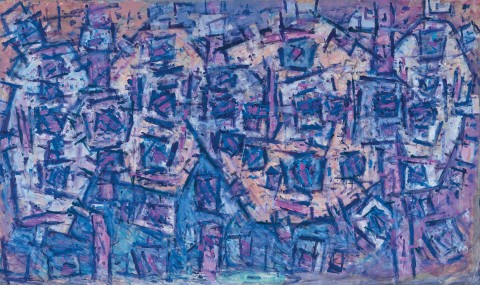MECHANICS OF THE MIND, also known as CONFIGURATION, c.1985
ROGER KEMP
synthetic polymer paint on linen
206.0 x 350.0 cm
bears inscription three times verso: COVENTRY No 1
bears inscription on stretcher bar verso: No 1
Joseph Brown Gallery, Melbourne, acquired directly from the artist
The Cbus Collection of Australian Art, Melbourne, acquired from the above on 12 July 1990
Roger Kemp – Recent Paintings, Coventry Gallery, Sydney, 6 – 31 May 1986, cat. 1
The Bus Collection of Australian Art, Wollongong City Gallery, New South Wales, 16 March – 12 April 1992, cat. 59 (as ‘Configuration’)
Art in a Time of Change, Hazelhurst Regional Gallery, Sydney, 21 January – 9 April 2000
A Century of Australian Art, Gosford Regional Gallery, New South Wales, 14 April – 28 July 2000
on long term loan to Wollongong City Gallery, New South Wales
Nainby, B., Stanhope, Z., and Furlonger, K., The Cbus Collection of Australian Art, in association with Latrobe Regional Gallery, Melbourne, 2009, p. 222
Roger Kemp is often described as ‘an artist’s artist’. Indeed, as Patrick McCaughey has written, he ‘embodied to successive generations the very idea of what it was to be an artist. It was a calling, not a career.’1 Grounded in geometry and mediated by gesture, his bold abstract paintings are unique within late twentieth century Australian art, revealing both the singular vision and expressive hand of their maker. Kemp’s purpose also set him apart. There is no narrative in his work, no obvious figuration or representational aim. He sought instead, to express a deeper meaning through his art, a personal perspective ‘that alluded to the timeless and universal, a means to articulate his experience of a higher truth.’2
Painting full-time from 1966, the 1970s saw Kemp’s practice widely acknowledged. Represented in the inaugural Sydney Biennale in 1973, he was awarded an OBE for services to Australian art in 1977, and in 1978, a group of works was acquired for the developing national collection. Although a stroke in 1980 slowed him down and required him to relearn the use and control of his body, Kemp’s creative drive remained strong. Initially working on a small scale, he was soon producing vast mural-sized paintings which, during the previous decade, had become such a signature element of his oeuvre. Further accolades and recognition were to follow too, including a commission (completed in 1984) to produce a suite of large-scale tapestries for the Great Hall at the National Gallery of Victoria – well known to visitors to the gallery for decades to come.
Painted around 1985, Mechanics of the Mind exemplifies the expressive power of Kemp’s work. Repeated geometric shapes and lines create an overall pattern from which an irregular central form emerges. Delineated in part by subtle variations in colour, the dusky pinks and white of the centre are surrounded by shades of blue and purple which are characteristic of Kemp’s distinctive, immediately recognisable palette. The scale on which he worked demanded that painting was a very physical act and beginning with a preparatory sketch to outline the composition, he then worked freely, ‘without traces of mannerism, artifice or guile… There was no apparent struggle, no erasures or revisions.’3 At over two metres high and more than three and a half metres in length, Mechanics of the Mind is a monumental work which vibrates with energy and draws the viewer in with the purity of its painterly expression.
1. Patrick McCaughey quoted in Heathcote, C., The Art of Roger Kemp, Macmillan, Melbourne, 2007, p. 168
2. Heathcote, C., A Quiet Revolution: The Rise of Australian Art 1946 – 1968, Text Publishing, Melbourne, 1995, p. 7
3. Heathcote, 2007, op. cit., p. 140
KIRSTY GRANT
